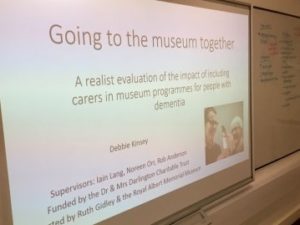 Debbie Kinsey is a PhD researcher at Exeter Medical School examining museum programmes for people with dementia, with a particular focus on how including caregivers has an impact on the person with dementia, the carer, and the relationship between them. Her broader research interests include living well with chronic health conditions (particularly those acquired in adulthood), the arts and health, and accessibility in its many forms.
Debbie Kinsey is a PhD researcher at Exeter Medical School examining museum programmes for people with dementia, with a particular focus on how including caregivers has an impact on the person with dementia, the carer, and the relationship between them. Her broader research interests include living well with chronic health conditions (particularly those acquired in adulthood), the arts and health, and accessibility in its many forms.
When you first start your PhD you are not actually technically a PhD student. You start registered as an MPhil student and, after a year or so, you do your upgrade to being a fully-fledged PhD student.
The process of your upgrade is different between different universities and even between different departments at the same university. So it’s worth checking what the requirements are for your department and, crucially, what the deadlines are, as the timing can also differ.
In my department I had to upgrade at about 1 year in. I had to choose two internal examiners, one of which had to be a more senior member of staff. And one month before the agreed date I had to submit:
- A brief report on my PhD progress & plans. It had a tight limit of 4-6 pages, but you could also add appendices. I attached a review paper I had just submitted to a journal.
- A (very brief) report from my lead supervisor, signed by my whole supervisory team
My actual upgrade involved:
- A 30-minute presentation about my PhD, open to all staff & students with a Q&A
- A mini-viva with my examiners straight afterwards. Mine only lasted about 45 minutes.
I was really nervous just beforehand, but it was actually completely fine.
The presentation:
I hate presenting – I’m not a ‘performer’ and I always fear I’ll be having a bad brain fog day, which includes word-finding & memory problems – not ideal for presenting! But it went well and quite a few PhD students came in support, so it helped knowing the audience would be a friendly one. (I’ll write a post at some point about preparing for a presentation when you have these kinds of spoonie issues).
Also – my lovely officemate came a bit early and brought me a bottle of water & a chocolate treat. I will definitely be doing that for other people in the future because I really needed them!
Tip #1: None of the questions I had prepared for came up in the Q&A, but a lot of that thinking through helped in the viva. So practice answering questions out loud you think people might ask!
The viva:
I had great examiners, which helped a lot because I knew they would be constructive and helpful in any criticisms/questions, rather than combative/mean. I found as soon as the viva got going my nerves very quickly disappeared. In part, that was because my examiners made me feel relaxed and comfortable, but also because it was basically a chat through my work, and ideas of things to think about or to include or to be clearer on. The viva went through, in roughly chronological order, from why I chose the specific topic that I did, to each of my studies, to analysis, to my publication/dissemination plan. We also talked about how my work fits in a wider context, which made me realise I could expand my thinking in how it’s situated much more.
It went very quickly, and I found it really helpful and motivating. If I didn’t have to do a presentation I’d even say the whole upgrade is quite enjoyable in a nerd way.
Tip #2: If you do get a say in who your examiners are, think carefully about your choice! What you want is someone who will be helpful to you and your PhD, whatever that means to you.
I did have the option for one of my supervisors sit in on the viva as an observer to take notes. I didn’t. In lots of ways this would have been helpful because so much of what the examiners are saying/suggesting is useful and there are only so many notes you can make yourself whilst also trying to think and answer questions. But, I know that I personally find being ‘observed’ extremely nerve-wracking so I would have found it more pressurising than helpful (even though all my supervisors are great).
Tip #3: I’d probably recommend to most people that having your supervisor there would be helpful, but remember to think about what would work for you.
I was surprisingly exhausted afterwards, even though it wasn’t a very long process, but I’d planned work things in for that afternoon. Don’t do this! I took the next day off and watched Buffy in my pyjamas while eating Lebkuchen, which was the better plan.
Tip #4: Take a bit of time out afterwards! Most of the actual work for the upgrade happens before it – in writing & preparing your submission – but you will definitely need a break. Have a little time out, relax, and come back motivated to get cracking – as an Official PhD Student.
 I think the important thing to remember is that it isn’t a test, but is supposed to be a helpful process to give you a milestone in the long PhD journey and an opportunity to get some feedback on your work from experts outside of your supervisory team.
I think the important thing to remember is that it isn’t a test, but is supposed to be a helpful process to give you a milestone in the long PhD journey and an opportunity to get some feedback on your work from experts outside of your supervisory team.
You can do the thing.
This post comes from Debbie Kinsey’s personal blog:
https://debbiekinsey.wordpress.com/2018/12/07/phd-chat-my-phd-upgrade-experience/
You can find out more about Debbie and her Research by following her on twitter @debbie_kinsey

